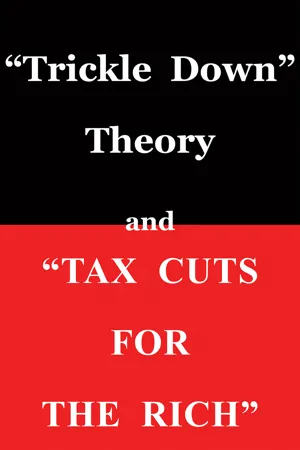We fight for and against not men and things as they are, but for and against the caricatures we make of them.
J.A. Schumpeter[1]
At various times and places, particular individuals have argued that existing tax rates are so high that the government could collect more tax revenues if it lowered those tax rates, because the changed incentives would lead to more economic activity, resulting in more tax revenues out of rising incomes, even though the tax rate was lowered. This is clearly a testable hypothesis that people might argue for or against, on either empirical or analytical grounds. But that is seldom what happens.
Even when the particular tax cut proposal is to cut tax rates in all income brackets, including reducing tax rates by a higher percentage in the lower income brackets than in the upper income brackets, such proposals have nevertheless often been characterized by their opponents as “tax cuts for the rich” because the total amount of money saved by someone in the upper income brackets is often larger than the total amount of money saved by someone in the lower brackets. Moreover, the reasons for proposing such tax cuts are often verbally transformed from those of the advocates— namely, changing economic behavior in ways that generate more output, income and resulting higher tax revenues— to a very different theory attributed to the advocates by the opponents, namely “the trickle-down theory.”
No such theory has been found in even the most voluminous and learned histories of economic theories, including J.A. Schumpeter’s monumental 1,260-page History of Economic Analysis. Yet this non-existent theory[*] has become the object of denunciations from the pages of the New York Times and the Washington Post to the political arena. It has been attacked by Professor Paul Krugman of Princeton and Professor Peter Corning of Stanford, among others, and similar attacks have been repeated as far away as India.[2] It is a classic example of arguing against a caricature instead of confronting the argument actually made.
While arguments for cuts in high tax rates have often been made by free-market economists or by conservatives in the American sense, such arguments have also sometimes been made by people who were neither, including John Maynard Keynes[3] and Democratic Presidents Woodrow Wilson[4] and John F. Kennedy.[5] But the claim that these are “tax cuts for the rich,” based on a “trickle-down theory” also has a long pedigree.
President Franklin D. Roosevelt’s speech writer Samuel Rosenman referred to “the philosophy that had prevailed in Washington since 1921, that the object of government was to provide prosperity for those who lived and worked at the top of the economic pyramid, in the belief that prosperity would trickle down to the bottom of the heap and benefit all.”[6] The same theme was repeated in the election campaign of 2008, when presidential candidate Barack Obama attacked what he called “the economic philosophy” which “says we should give more and more to those with the most and hope that prosperity trickles down to everyone else.”[7]
When Samuel Rosenman referred to what had been happening “since 1921,” he was referring to the series of tax rate reductions advocated by Secretary of the Treasury Andrew Mellon, and enacted into law by Congress during the decade of the 1920s. But the actual arguments advocated by Secretary Mellon had nothing to do with a “trickle-down theory.” Mellon pointed out that, under the high income tax rates at the end of the Woodrow Wilson administration in 1921, vast sums of money had been put into tax shelters such as tax-exempt municipal bonds, instead of being invested in the private economy, where this money would create more output, incomes and jobs.[8] It was an argument that would be made at various times over the years by others— and repeatedly evaded by attacks o...
